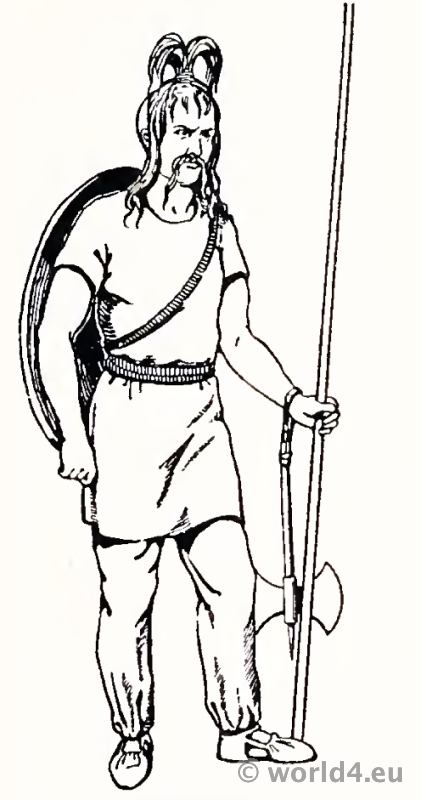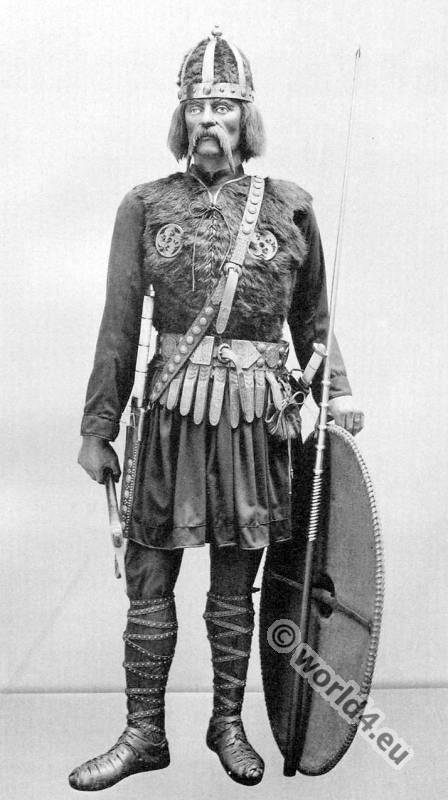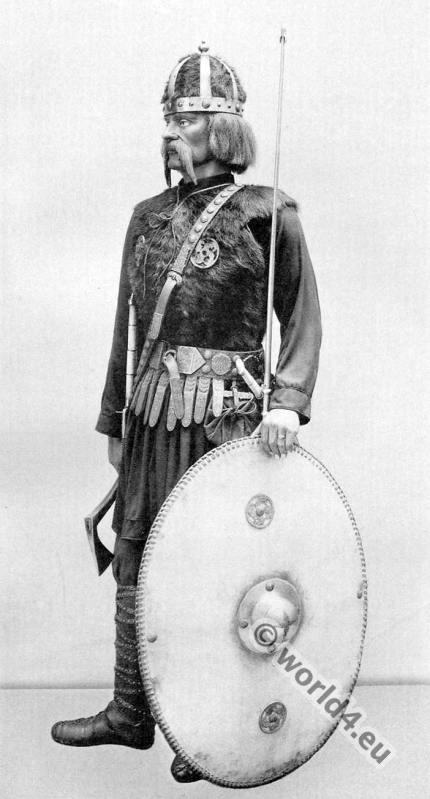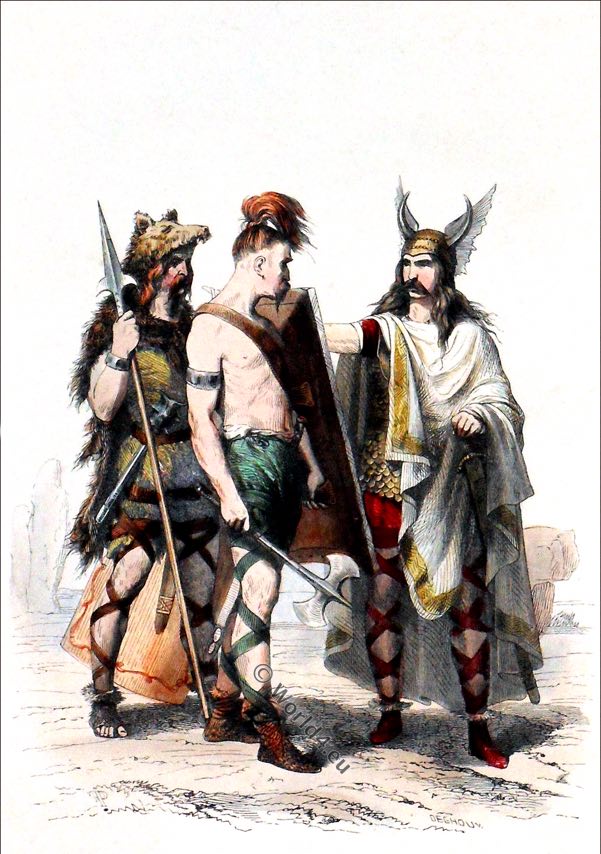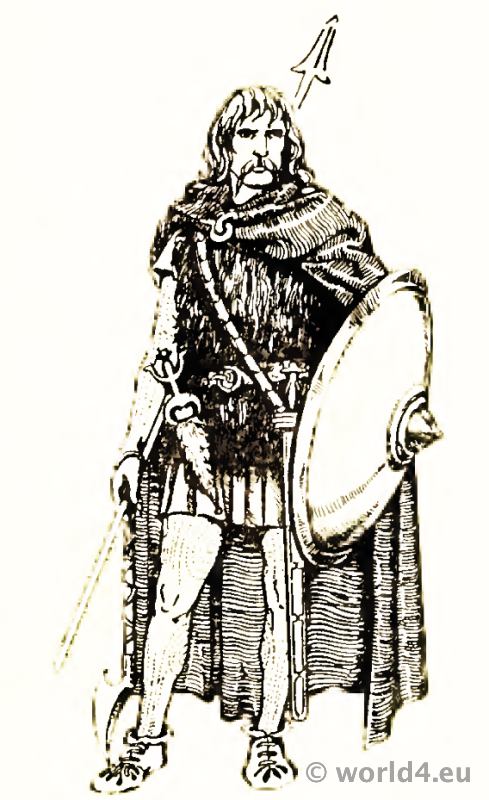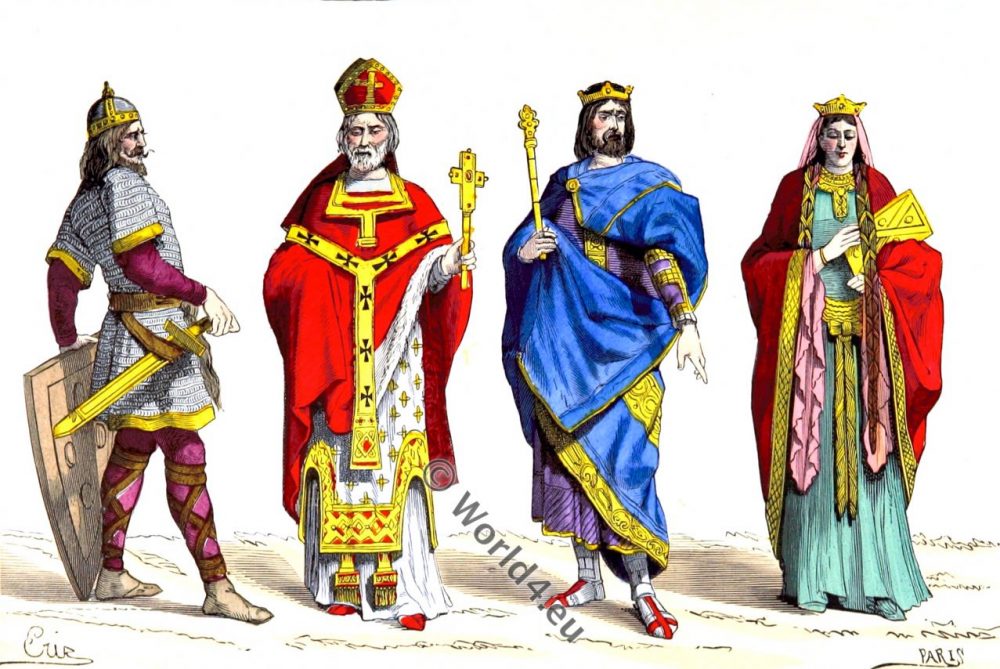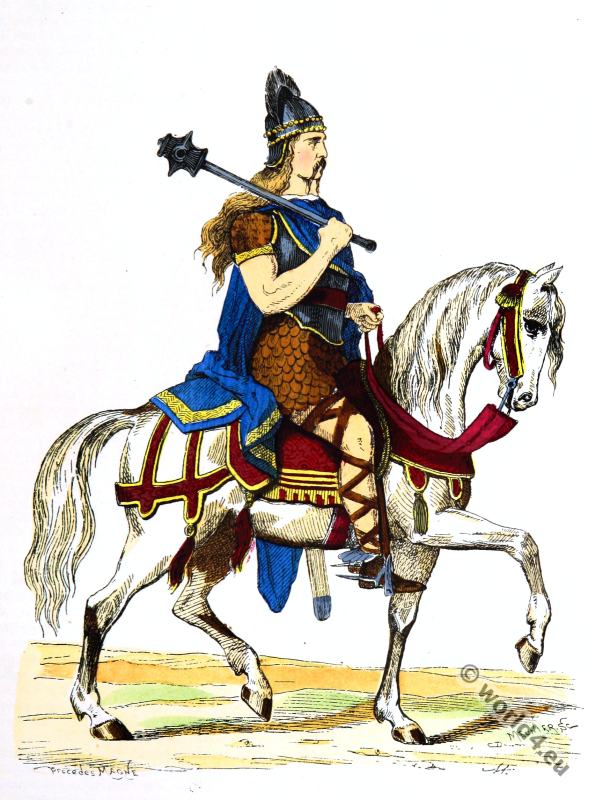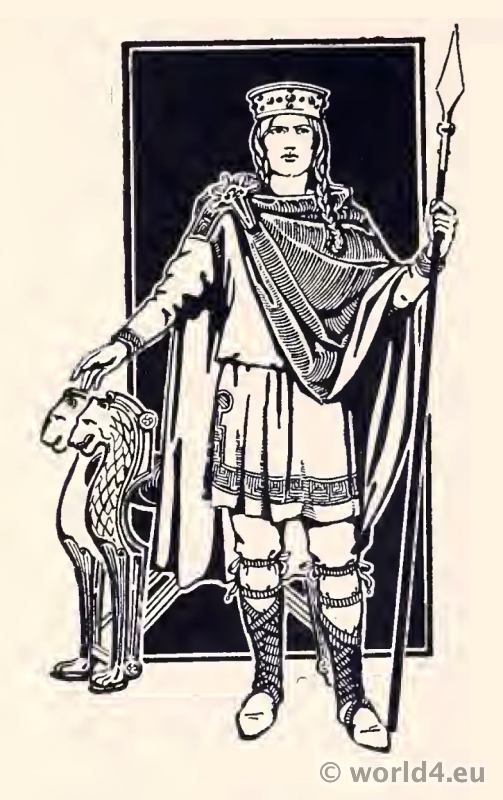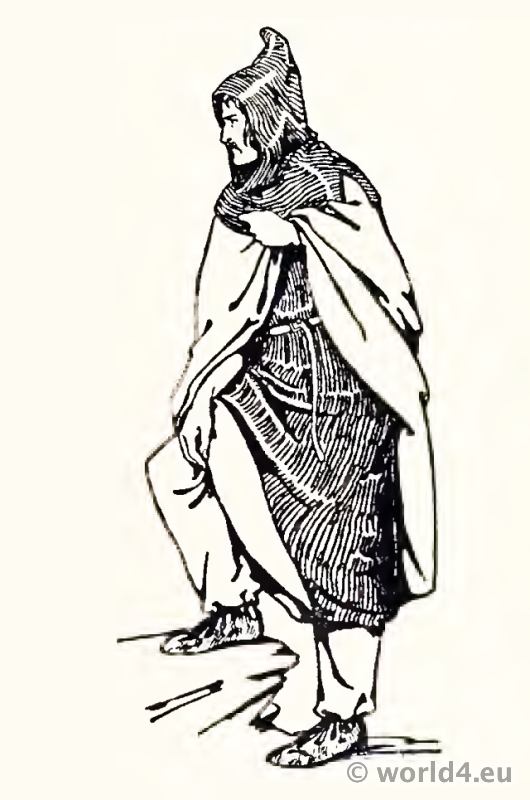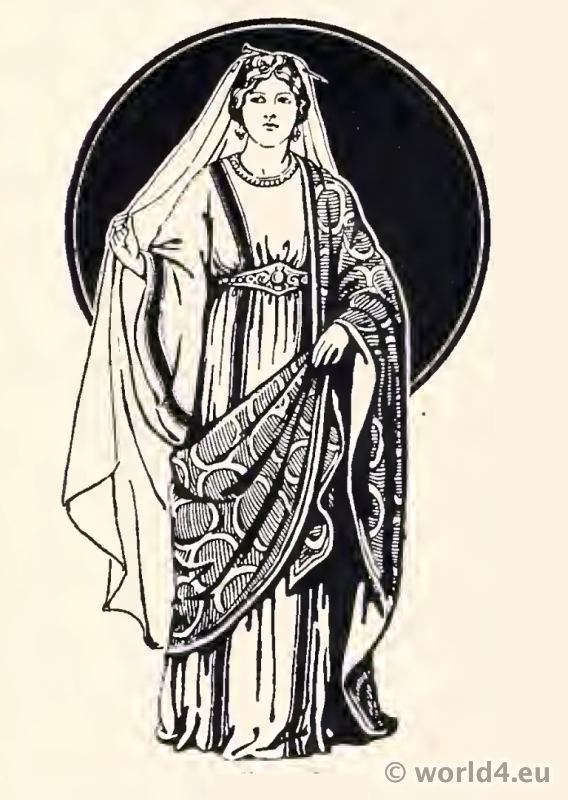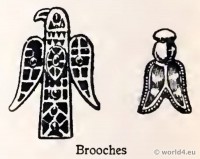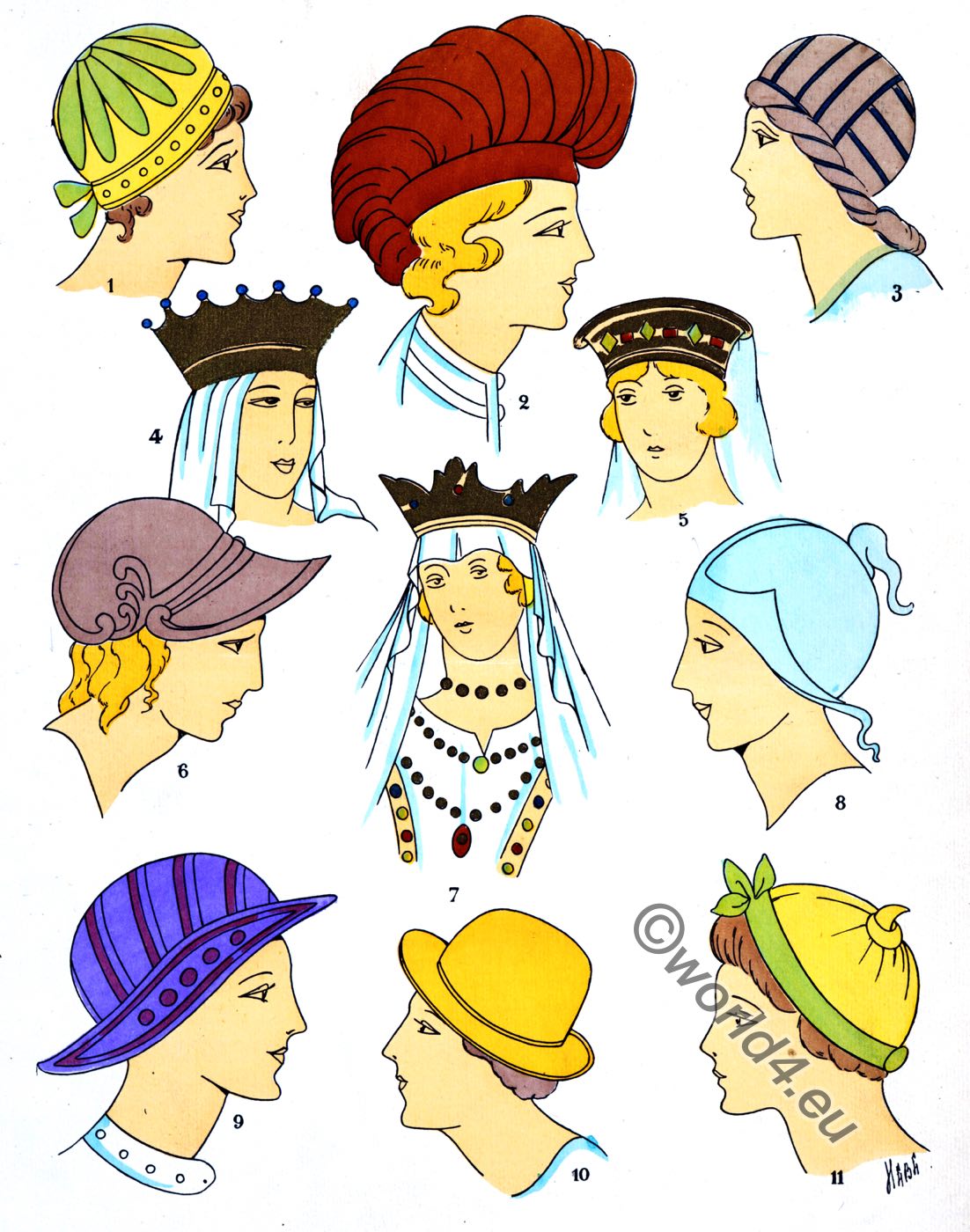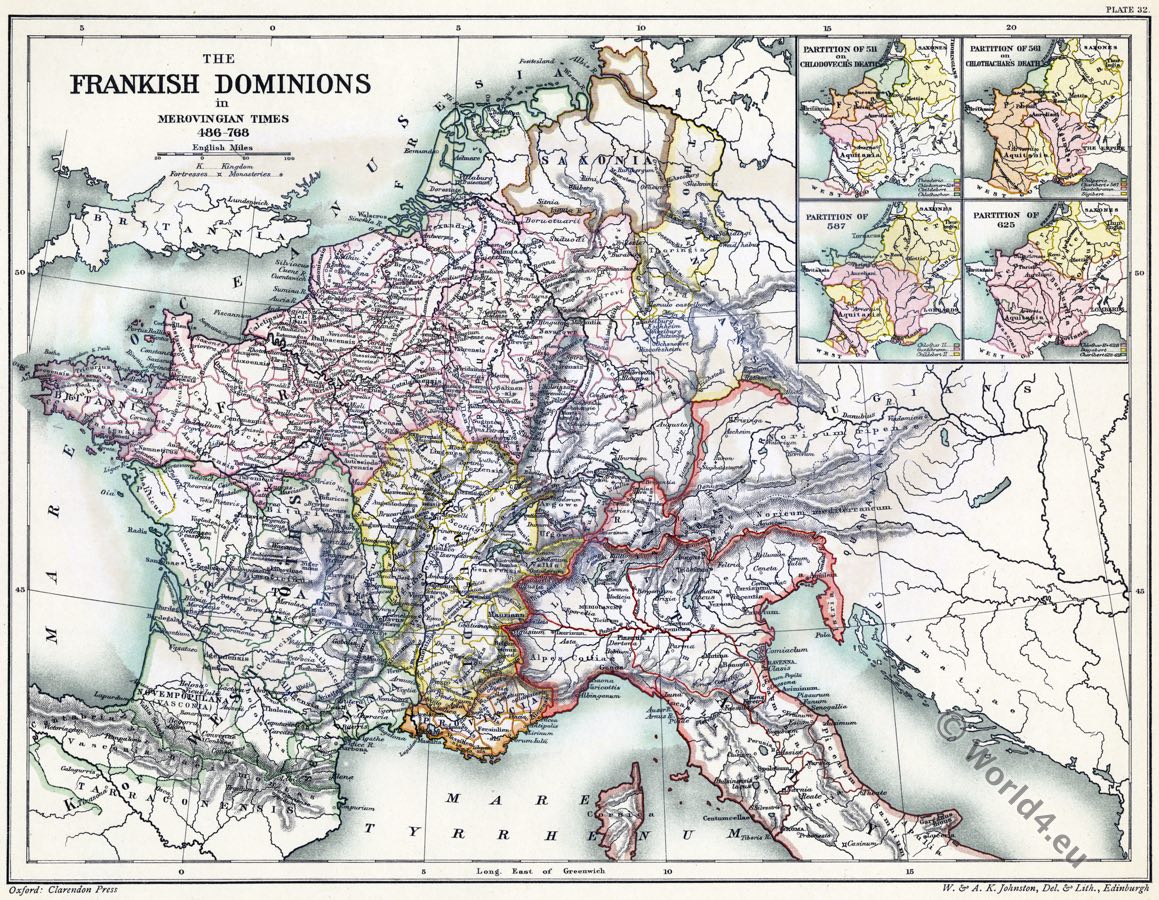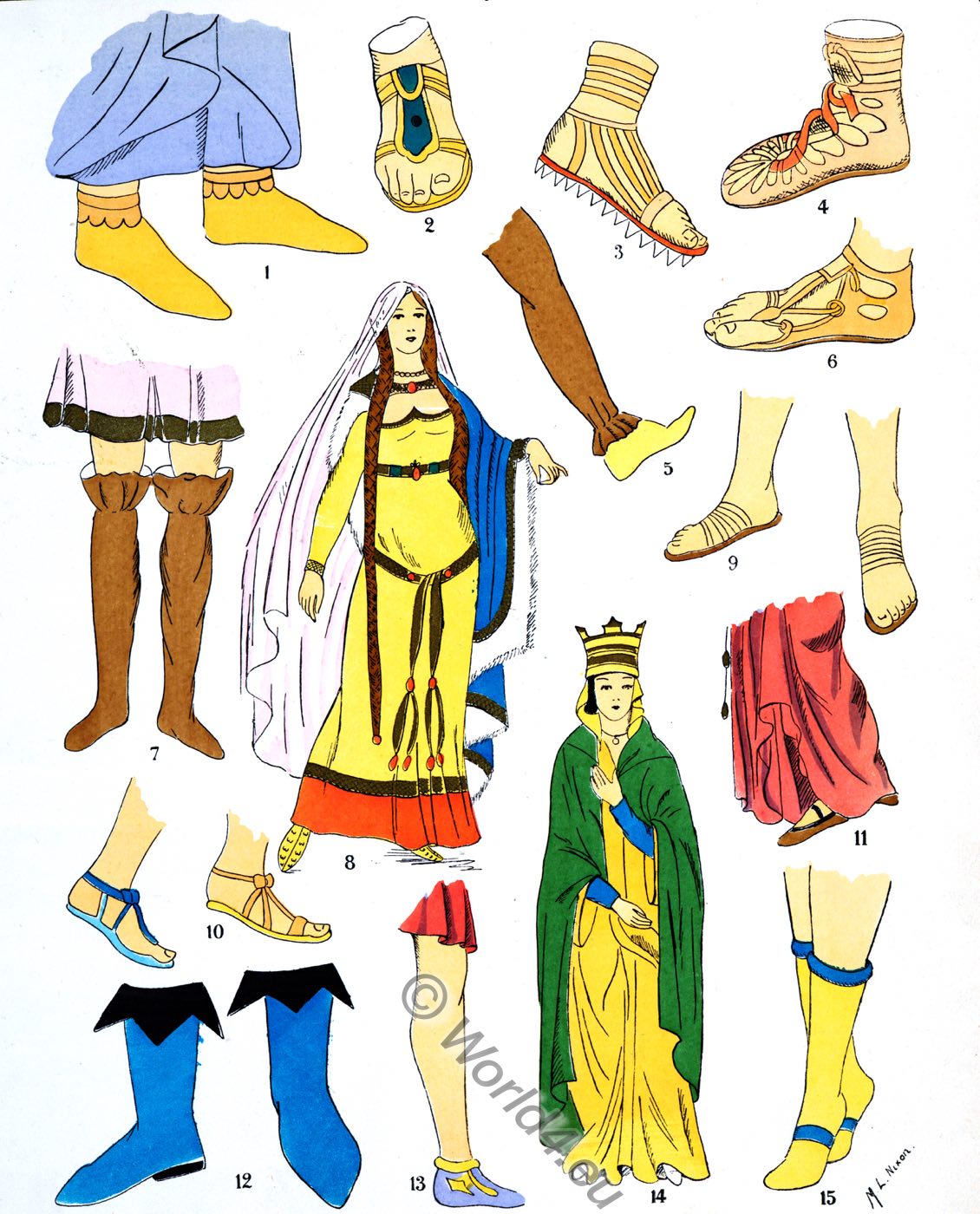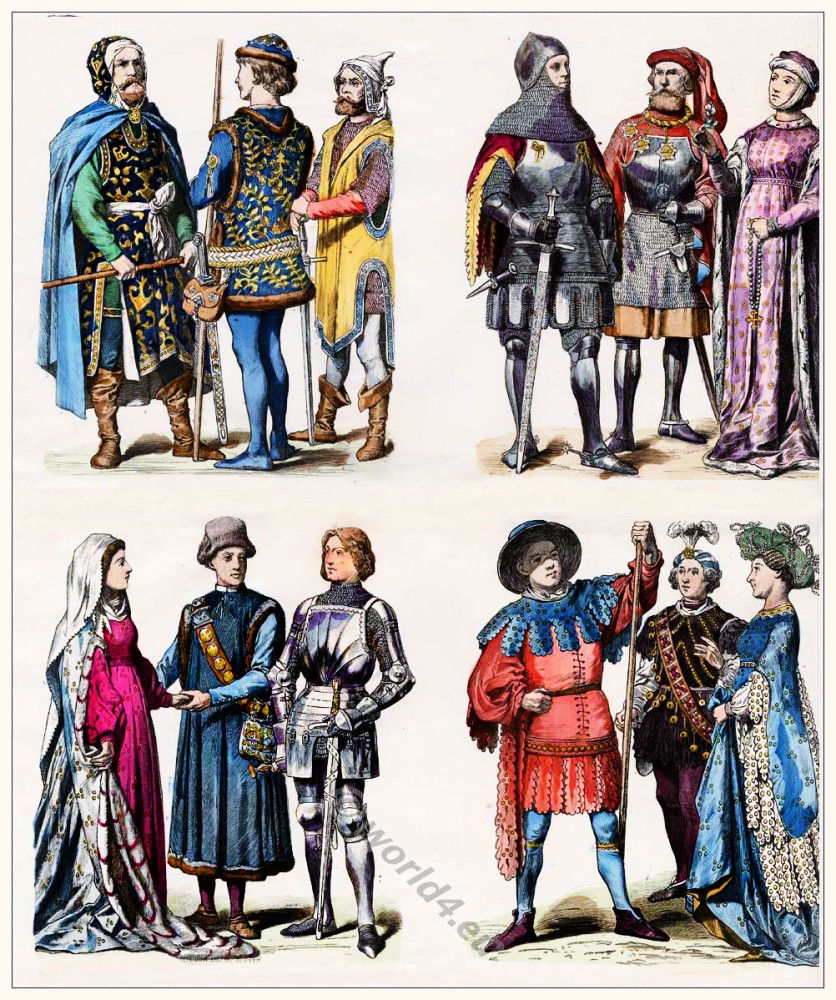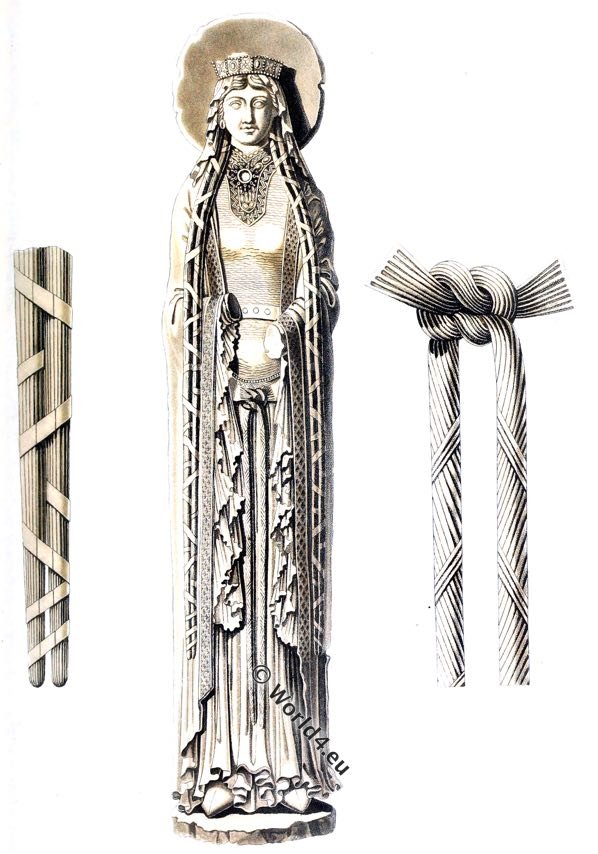Frankish Merovingian costume history of the 4th and 5th century.
Costume of the Early Franks.
Our earliest knowledge of the Franks after their settlement in Gaul is gained from the historian Sidonius Apollinaris (430-488). He describes them as “monsters,” and “from the top of their red skulls descends their hair, knotted on the front and shaved in the nape of the neck.
Their chins are shaven, and instead of a beard they have locks of hair arranged with the comb” (moustaches) (see Fig. 99). He relates that they had large strong limbs, and wore a tight-fitting tunica to the knee, with a wide girdle round their “lean stomachs.” To hurl their two-edged axes, turn their shields round and round, and to bear down the enemy before their spears was child’s play to them.
He also tells us he saw the Franks enter the city of Lyons in 470, attired in close-fitting tunicas reaching to the knee, with exceedingly short sleeves scarcely covering the shoulders, made of some striped material. Over this they wore a cloak (sagum) of green cloth with a red border. They were girt with a broad belt, ornamented with metal studs, and wore their swords suspended on the left side by a baldric crossing the breast. Their thighs and legs were bare, but they had laced boots of undressed leather reaching to the ankles. The tunica of their young King Sigismer was of white silk, and his sagum was of a brilliant scarlet.
Like the gold that gleamed upon his dress, was his hair. Beautiful in hue as the vermilion of his sagum was his complexion. The fairness of his milk-white silk attire was rivalled by his skin.
He had come to celebrate his nuptials with the daughter of a Burgundian chief. Agathias, writing in the early sixth century, tells us that they fought with their chests and backs bare. Their legs were girt with linen or leather bracco of the same style as those worn by the Teutonic auxiliaries seven hundred years earlier. The bracco was the distinctive dress of the Teutonic tribes, but after their arrival in Gaul this garment was more or less discarded by the upper classes. Later, they adopted pedules (see Byzantine Empire,), which became a familiar feature of Frankish dress.
Other authors of this time mention “bright striped dresses,” and “bright striped mantles,” so the art of the dyer must have reached a high standard. Also “bright dress stuff which the Friesians spred as merchandise”—evidently a primitive woollen material which afterwards became known as “frieze.” This is a curiously early record of its existence, as it was undoubtedly considered a novelty when introduced into England in Edward III.’s reign.
The Nobility.
The dress of a Frankish noble was a narrow tunica of soft material. It reached just above the knees, was striped or plain, with a bright colour as a border. Over this would be worn sometimes a short jacket of fur, without sleeves. A belt with a buckle was fastened round the waist, set with precious stones and studs of gold, and from it was suspended a small sword on the right side. A larger sword hung on the left side, by a baldric of leather, ornamented with studs, crossing the breast.
The legs were bare from the thighs downward, and on the feet were shoes of undressed leather laced on the instep and turning over at the ankles (see Fig. 100). It was very usual to have the shoes open at the top, exposing all five toes as far as the joints. Tattooing was still a prevalent fashion, common to both nobles and people as late as 785, and the short sleeves and tunicas worn showed off this decoration to advantage. Cloaks, with borders of different colours, were fastened either in front or on the right shoulder with a fibula.
At the end of this period, the nobility ceased to wear the short over-tunic of fur or skin. It was worn only by freemen and serfs, with whom it remained in fashion for several centuries longer. The hair of princes and nobles was worn long and flowing, it being a distinguishing mark of nobility. Young men shaved their faces, leaving only a small moustache, but among the aged and learned long beards were at all times reverenced. A peculiar style of dressing the hair was in vogue among some of the tribes which formed this race. The men shaved the back of the head, allowing the hair on the front to grow to a very great length. This they tied up in a knot on top, with the flowing ends falling down on both sides like a horse’s tail. The fashion appears to have been borrowed from the Aquitanians, a tribe inhabiting that part of Gaul which lies between the Garonne and the Pyrenees, among whom it remained in fashion until the eleventh century.
Jewellery of the early Franks. Articles of personal adornment consisted of fibulae, ear-rings, bracelets, belt-buckles, and plates of metal for decorating skin jackets, waist-belts and sword-belts. Bronze, often gilded, was the chief metal used, and, among the wealthy, ornaments of gold. The fibulae were of especially beautiful designs, and made of gold or bronze, inlaid with pebbles and semi-precious stones. Bracelets, often worn by men on the right arm, and ear-rings were of the same materials. Necklaces of coloured glass beads were in common use. The buckle fastening the waist-belt was an important item, and was richly chased or inlaid.
State Costume — Men 6th, 7th and 8th Centuries.
The rise of the Frankish nation in the fifth century gave no little concern to the officials of the Eastern Empire; and it was deemed wise to add their barbarian chieftains to the lengthy list of similar worthies whose propitiation appeared to be expedient. After the success of Clovis in his war (507) against the Goths in Gaul, the title of “Augustus” was conferred upon him (510) by the Emperor Anastatius, who thereby gave tacit sanction to the usurpation of Gaul. Gregory of Tours narrates that on the day the insignia of his honours were delivered to him, Clovis set aside his barbarian attire, and robed himself in tunica palmata and paludamentum, placing a jewelled diadem upon his head. He adopted with alacrity the Byzantine mode of dress and, his example being followed by most of the nobles and Court dignitaries, the customs, costume and etiquette of Byzantium speedily displaced former modes and practices at the Court of Clovis and his successors. Long hair, however, continued to be worn by Frankish notabilities, and a few other variations from Byzantine models will be referred to in connection with the examples which follow.
The State costume of a Frankish king of the Merovingian Epoch is shown in Fig. 101. In general appearance it is of the familiar type described in the preceding chapter. The tunica, save for a slight variation in its decoration, is in every way the same as that worn by Byzantine nobles. The paludamentum likewise; but it is simplified and without ornament except for the fibula of Frankish workmanship which fastens it. The leg-coverings are characteristic of Frankish dress. This king wears bracco tied at the knees, and over them pedules cross-gartered from the ankles upward. Shoes of a simple form, in leather or cloth, are worn. A touch of barbarism remains in the hairdressing. It was the custom among members of the Frankish reigning house to allow the hair to grow to a great length, as a sign of royal birth. The first to attain to the title of king was “Clodian of the Long Hair,” and the fashion originated thus. It is shown in Fig. 101, braided in long plaits on either side of the face, and with the extremities rolled up and fastened.
The crown is of Byzantine design, but wrought in rather a clumsy manner by a Frankish gold-smith. A spear is held in the hand, in imitation of Byzantine emperors and their Holy Lance, and as part of the Frankish insignia as a chief. Some examples of goldsmiths’ work came from Constantinople in the early days of this epoch. Later, when Clovis overthrew the Visigothic power in Gaul (507), the Franks obtained possession of large quantities of masterpieces of the goldsmiths’ and other arts, stored in different strongholds by Alaric I. — 100t which he had deposited there after the sack of Rome in 410.
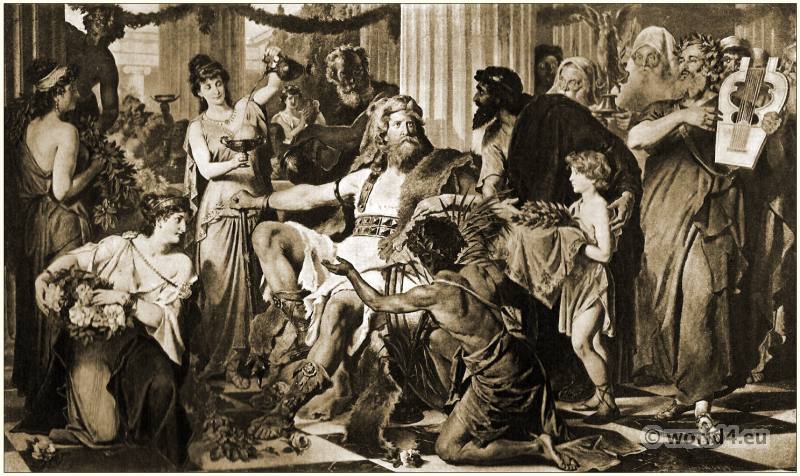
These priceless treasures accumulated by the Romans comprised gold and silver cups, plates, dishes, furniture, jewellery, textiles, and “twenty cases to hold the books of the Gospels.” This wealth was distributed by the successors of Clovis among the churches which were afterwards built in Christianised Frankish Gaul. Chilperic I. encouraged the arts, and sent to Constantinople for craftsmen whom he established in the vicinity of his palace.
Goldsmiths’ Work.
The Bishop-Saint Eloi, or Eligius, was born at Cadillac, near Limoges, in 590. As a child he showed great artistic talent, and was placed later with Abbo, Master of the Mint at Limoges, where he made rapid progress in goldsmiths’ work. He became coiner to Clotaire II. (613) and treasurer to Dagobert the Great (628). He is famous as a mastergoldsmith, and is responsible for the creation of many works of art, especially furniture. He made two chairs of gilded bronze set with jewels, and one of them, known as ” Dagobert’s Chair,” is still extant (see Fig. 101). A back and sides were added by Abbot Suger in the twelfth century. Saint Eloi became a very important personage at Court, and dressed very magnificently, “more for propriety than taste.” His under-garments were made of the finest linen, and his outer ones were of the richest silk, embroidered with gold and jewels. Having amassed great wealth, he acquired a distaste for worldly life and became a priest, conforming strictly to the Irish monastic rule of S. Columba. He was appointed Bishop of Noyon (640), and died in 660. He is the patron – saint of goldsmiths and metalworkers.
Fig. 102 shows a Frankish noble or official at the Court of a Frankish king where Byzantine influences have considerable sway. Attention is directed to the pocket attached to the waistbelt, to the bracco, and pedules. The foot coverings exposing the toes are of Byzantine origin. This type of costume remained in use from the sixth century to the ninth, and was worn at the Court of Charles the Bald (842-877). During the reign of Dagobert the Great, lavish display was manifested in the costume and accessories of a Court which rivaled in magnificence that of the Eastern emperors.
Frankish chieftain or noble in war dress, fifth to the ninth century. In battle the nobles put on a short jacket of fur over their cloth or linen tunica. These fur jackets had no sleeves, reached to just above the hips, and were very often covered (thickly or thinly) with metal bosses. Fig. 103 shows a chief wearing, instead of this fur jacket, the lorica of leather, and above it a cuirass of mail composed of linen or leather thickly sewn over with scales of leather or horn, invariably gilded. It was made more secure by leather straps passing over the shoulders and around the chest — a distinctly Teutonic device.
The helmet bears evidence of its Teutonic origin but it was also very general for a warrior of this period to go bareheaded. A large knife or dagger, called a “scramasaxe,” was carried on the right side, suspended from the waist-belt. A large sword hung on the left side, by a baldric of leather and studs, or a chain, crossing the breast; these long swords were only used by princes and chiefs. A round convex shield was carried, generally made of the wood of the lime tree, strengthened with a boss, studs, and rim of iron.
The shield occasionally had devices painted on it. A spear was nearly always carried in the hand. To these were often added an axe, called a “francisque,” either stuck in the belt or carried in the right hand by a loop at the end of the handle.
Costume of the Middle Classes Men.
An ordinary warrior of this period wore a tunica of cloth with short sleeves, a belt with a buckle of bronze at the waist to carry the scramasaxe, and a pouch containing a firestone, eating-knife, comb, steel, money and similar necessities. Short bracco, just showing beneath the tunica^ left the knees bare. Coarse pedules of white wool on the lower leg, cross-gartered with leather bands, and shoes of leather, completed the dress (see Fig. 104). A spear was carried in one hand, and the francisque in the other. A basin-shaped helmet of metal and leather might be worn, but the head was sometimes uncovered, the hair flowing, and the face clean shaven with the exception of the upper lip.
Lower Classes.
The lower order of Franks all wore the drawers of linen or leather, but unlike other races at this period, they cross- gartered them all the way up the leg to the waist with straps of hide. The chest and back were bare, or jackets without sleeves, made of skins laced together with thongs of leather, might be worn.
Hair. The Frankish chronicler, Gregory of Tours, says that the common people were commanded by an express law to cut their hair close round the middle of their foreheads, in contrast to the nobility. The beard and moustache were allowed to grow long. Fig. 105 shows a man of the people. His tunica is much longer than as hitherto used, and could only have been worn so on exceptional occasions.
The Franks were an active people, and garments of this kind were cumbersome. The bracco are not in this case cross-gartered; but the wearer evidently prefers a costume suited to relaxation and comfort in a cold climate. The cloak is surmounted by a cucullus or hood, which descends over the shoulders, forming a cape. The shoes are of primitive make, in untanned hide.
The Glove.
First mentioned as a covering for the hand. Known in very early times. Rebecca put skins on the hands of her younger son to secure for him his elder brother’s birthright. Latin: “Manica,” meaning a sleeve over the wrists and knuckles. The manica with separate fingers attached was used by the Romans. Low Latin: Wantus. Celtic: Golof = to cover. Scandinavian: Vottr and Glofar. Anglo-Saxon: Glof. Swedish: Wante. French: Gant. Spanish = Visigothic: Guando. English: Glove, gauntlet. The existence of the name in different languages proves that the glove in its primitive form—a bag—was used by these nations.
During the Merovingian Period the “wantus” came into general use with the wealthy. In shape it was a bag, with a separate compartment for the thumb. It was made of finely-dressed skins with the fur inside, ornamented outside with gold and set with jewels on the back. Sometimes the fur was worn outside, and the glove lined with a warm material. Gloves were used only for cold weather. Frankish warriors of this period wore bags of skin on their hands as a protection against cold weather when fighting in northern countries.
Costume of the Nobility Women.
The Frankish ladies’ costume of the period evolved under the influence of Rome and Constantinople, but was carried out on slightly different lines. It would be the model for any fashionable British lady of the time; but the chaotic disorder in Britain was not conducive to much interest in the vagaries of fashion.
Pig. 106 shows a noble lady of this epoch. She wears the dalmatica with the clavus, confined at the waist by a belt of goldsmiths’ work. Over this is draped a semicircular cloak, woven with a gold pattern in circles, and on the head is placed a veil attached to the hair by a large ornamental pin. Reference should be the dress of a Roman lady of the fourth century, from whose costume this Frankish lady has sought inspiration in every particular except the palla contabulatum.
Jewellery of the Franks.
At the time of their migration, the Franks, the most of the tribes of Teutonic stock, were well acquainted with the metalworker’s craft. In their early days the Teutons had come under the influence of the Sarmatians, an ancient nomadic and warlike people possessing many characteristics of the Scythians, an older race from whom they are supposed to have descended. From these sources the Teutons acquired a taste for articles of adornment of
original character, and a technique in craftsmanship unlike all Classic practice. When the Franks were established in France, they maintained their national traditions, and their metalwork ornaments were of solid, indeed clumsy, construction. In their design, natural objects were discarded, and high-relief modelling avoided. They covered the whole surface with a diffuse pattern very much akin to Eastern types of work. By the sixth century the work of Frankish goldsmiths compared very favourably with that of Byzantine artificers, and much of it was fashioned on Byzantine lines. Frankish jewellery owed a great deal to the energy, taste, and practical knowledge of S. Eloi, and it is due to him that the native work of the Merovingian Epoch equalled and often excelled the goldsmiths’ work of any other nation. Mosaic work in stones, glass, and paste was used freely by them for decoration, in a style corresponding with the Byzantine — both came from the same source, Persia.
Above picture: 1,3,28,34. Various bronze objects – 8,16. Finely engraved bronze torcs – 7. A tightly spiraled bronze fastener – 9,20,29. Simple neck ornaments – 26. Engraved bronze bracelet – 17,28,32. Bronze Fibulas – 12,19. Bronze belt buckle, Merovingian – 15. Bronze fastener with cross design – 18. Bronze fibula, Merovingian, found in Paris – 33. Bronze eagle ornament, encrusted with glass beads and precious stones – 23,25. Embroideries from Brittany, made at Pont-l’Abbé, located in Finistère, France.
Crowns. When the long-haired Frankish kings adopted the crown as a royal emblem, they copied it from those worn by contemporary Byzantine emperors. This applies also to the rest of their regalia.
Necklaces and bracelets of Teutonic origin gave place to those in fashion at Byzantium, but they retained an individual taste with regard to fibulae and buckles. Fibulae of the safety-pin type almost lost their original shape. The one shown here is an elaborated version of it. The flat diamond-shaped part which catches the point of the pin is incised with scroll work. The bridge is divided with an opening, and the part which holds the spring of the pin is highly developed and ornate. The particular design associated with Frankish fibulae has a semicircular head with radiating ornaments, and a long end, slightly curved at the top and then flattened to take the pin. These tall fibulae are of infinite variety, but all have the semicircular head.
Mosaic work and incised scrolls on gold form the decoration of other shorter and wider fibulae, but these follow the same lines as the preceding examples. Circular-topped brooches or agrafes offered tremendous scope to decorative artists, of which they took full advantage. They were very much used by Frankish nobles of the Merovingian and Carlovingian Epochs for fastening their rich cloaks. Smaller brooches, intended for pure ornament and not utility, were of various shapes, sizes and designs, a favourite one being a bird. These were minute specimens of enamel or mosaic set with jewels. Small gold ornaments, with pins attached, supposed to represent flies or bees, were used for numerous purposes, chiefly for fastening the veils worn by ladies of this time. Long pins, with quaint ornamental heads, were worn in the hair (see Fig. 106).
Buckles were an important and useful item of jewellery, and were used for fastening the waist-belts of the men, both in civil and war dress. They were made in two pieces, the tongue in one and the slot in the other, one of which—the tongue—is shown here. It is of fairly simple design when compared with one of the Mid-Merovingian Epoch. Beside being much larger—six, eight or even ten inches in length—the latter, illustrated here, is very ornate.
Related
Discover more from World4 Costume Culture History
Subscribe to get the latest posts sent to your email.


